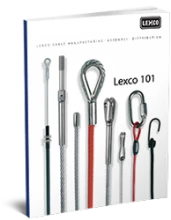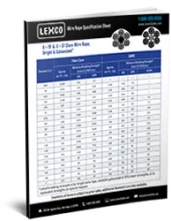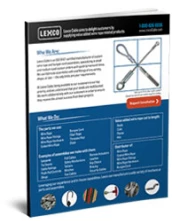A button stop is a cylinder with an inside diameter designed to accept one wire rope. Typically, a button stop is crimped at the end of a cable, but may also be crimped at an intermediate point. A button stop can act as a stopping mechanism in an assembly. Aluminum and copper button stops can be crimped with a hand tool; however, carbon steel and stainless steel button stops are designed to be machine-swaged.
Double shank balls are a swaged ball with shanks on both sides of the ball. One instance where double shank balls get chosen is when its being swaged at a point along the middle of an assembly. In those cases, there could be a load from both directions making the double shank a useful feature.
The common characteristic of an eye end is the round hole in The eyes head. This hole is the perfect connection point for a screw, bolt, clevis pin, etc. Lexco’s most popular eye end is the stamped eyelet (nickname: stake eye). This type of eyelet stamping is very economical when produced in diameters between 1/32” and 3/16”. Stamped eyelets are widely used for many types of lanyards, tethers, and related assemblies. Another common eye end is MS20668. Marine eyes are commercial grade SS316. Eye ends used in large diameter wire rope assemblies utilize a type called a closed swage socket. These are designed for machine-swaging.
Kwik-Grip is typically used for cable suspension applications such as suspended lighting, suspended signs, and suspended displays. It can be field installed and is easy to adjust. This product is typically used with 1/16” - 1/8” cable diameter. It allows the cable to be inserted through the fitting, exiting either out the side or through the opposite end of the Kwik-Grip. Also within this product line are cable coupler products, which have internal thread on on side and a cable exit hole opposite. These are also used for hanging cables, as long as there is a factory-installed ball on the 1/16” diameter wire rope.
This stainless steel turnbuckle has a closed pipe-shaped body. It’s similar to a cable railing turnbuckle except that it’s designed for higher load rating. This product line also contains stainless steel non-tensioning fixed fittings, such as marine eyes and swage jaws.
A plain ball is a spherical version of a button stop. Due to its spherical shape, the plain ball is designed to be rotary-swaged with tool and die (not recommended to hand-crimp). Plain balls are typically stainless steel but some sizes can be made in brass or zinc plated steel and they are weaker than single-shank balls because they have less surface area to attach to the wire rope.
Typically installed at the end of a wire rope assembly, single shank balls may also be installed at an intermediate point. Single shank balls are widely available in stainless steel per MS20664. In some sizes, Lexco also carries single shank balls in zinc-plated steel. Single shank balls are designed to be rotary-swaged with tool and die (not recommended to hand crimp).
An aluminum or copper sleeve comes in an hourglass shape. A stainless steel sleeve comes in an oval shape, with the exception of a stainless steel flemish sleeve. A carbon steel sleeve is typically oval, again except for the flemish version. Both carbon steel and stainless steel flemish sleeves are round with a tapered nose. The #1 use of sleeves is to form loops on wire rope or fiber rope. Both oval and hourglass sleeves can also be used to connect parallel cables in a lapover slice. Aluminum and copper sleeves can be hand-crimped, as can some stainless steel sleeves, but with greater difficulty. All sleeves are designed to be machine-swaged with a round after-swage diameter.
A spelter socket is attached to the end of a wire rope by either resin compound or poured zinc. Spelter sockets come in different styles, such as closed eye and open clevis. Installation of spelter sockets is recommended to be performed in a controlled environment, such as a wire rope rigging shop
A swageless fitting is installed to the end of wire rope without crimping. This product line contains a number of different varieties. For example, Push-Lock® and Pull-Lock® are available for 1/8” and 3/16” cable railing projects. Electroline® is an industrial-duty type that requires some assembly but has higher breaking strength in comparison to a cable railing type.
The threaded stud has a blind hole on one side where a wire rope is inserted, and external thread on the other. The name “threaded plug” is typical when the crimp area and cable hole within are both short. Overall, the entire length of a threaded plug is smaller than its counterparts in this product line. “Threaded terminal” is a term that’s used when the threaded stud is for an architectural cable railing or marine cable application. “Swage stud” is an alias for a threaded stud.
A wire rope clip is comprised of a u-bolt with a saddle and hex nuts. It is most commonly used to form loops. Because you only need a wrench to tighten the nuts, the wire rope clip is ideal for field installations. For diameters 7/16” and below, a minimum of 2 wire rope clips is recommended for a loop. For diameters 1/2” - 5/8”, a minimum of 3 wire rope clips is recommended for a loop. For diameters 3/4” - 7/8”, a minimum of 4 wire rope clips is recommended for a loop.
This type of cable fitting is molded. In other words, the zinc is injected into a mold where it meets the end of a cable. The one reason to have a die-cast fitting is the fitting shape, for example you can die-cast a barrel which makes a ‘T’ shape with the cable but it would be very difficult to create that perpendicular shape in a crimped fitting. Another reason die-cast fitting might be chosen is because of size considerations. For example, in small diameters you can die-cast an eye fitting smaller than you could crimp the eye fitting. Another reason is for cost reasons. In some cases, where the assembly volume is very high, the end fitting can be die-cast more economically than a crimped fitting when you take the material cost into account. One draw-back of die-cast fittings is that the expense of the mold.
Want to learn more about Lexco’s wire rope specifications, or see
them in action yourself? Get started with some of our guides:

Discover an extensive range of cutting-edge products and components by exploring Lexco's impressive line card, designed to meet the diverse needs of nearly every industry.

Make informed decisions and select the perfect products tailored to your specific requirements by exploring Lexco’s carefully crafted spec sheet.

Get an inside look at Lexco Cable-who we are, what we do, and why we're the best cable manufacturer in the industry.